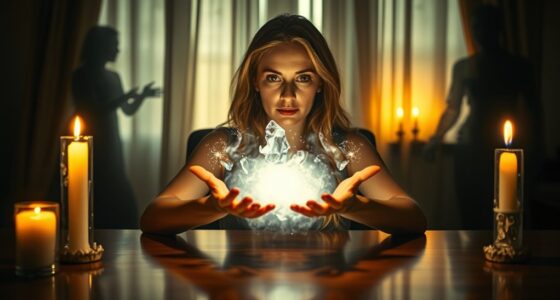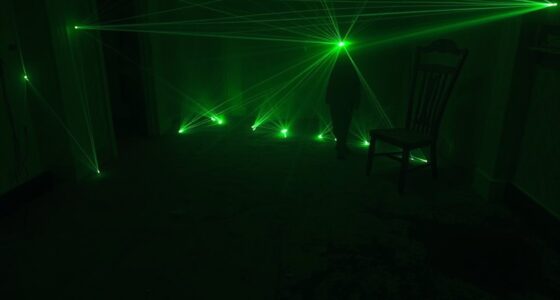Using thermal cameras to spot ghosts is an intriguing approach for paranormal investigation. These devices detect infrared radiation, allowing you to visualize temperature differences in your environment. By identifying cold spots and unusual heat signatures, you can uncover potential paranormal activity. However, be cautious of misinterpretations caused by reflective surfaces or drafts. Choosing the right camera is key to success, and you’ll discover tips and best practices to enhance your ghost hunting experience.
Key Takeaways
- Thermal cameras detect infrared radiation, allowing users to visualize temperature differences that may indicate paranormal activity.
- Cold spots are key indicators of ghostly presence; thermal cameras effectively identify consistent temperature drops in specific areas.
- Reflective surfaces can mislead thermal cameras, so it’s essential to analyze surroundings and camera angles to avoid false interpretations.
- Documenting findings meticulously and approaching results critically ensures responsible ghost hunting and accurate assessments of potential anomalies.
- Choose reputable brands like FLIR, Hikmicro, or Fluke, prioritizing high resolution and sensitivity for reliable thermal imaging results.
What Is a Thermal Camera?
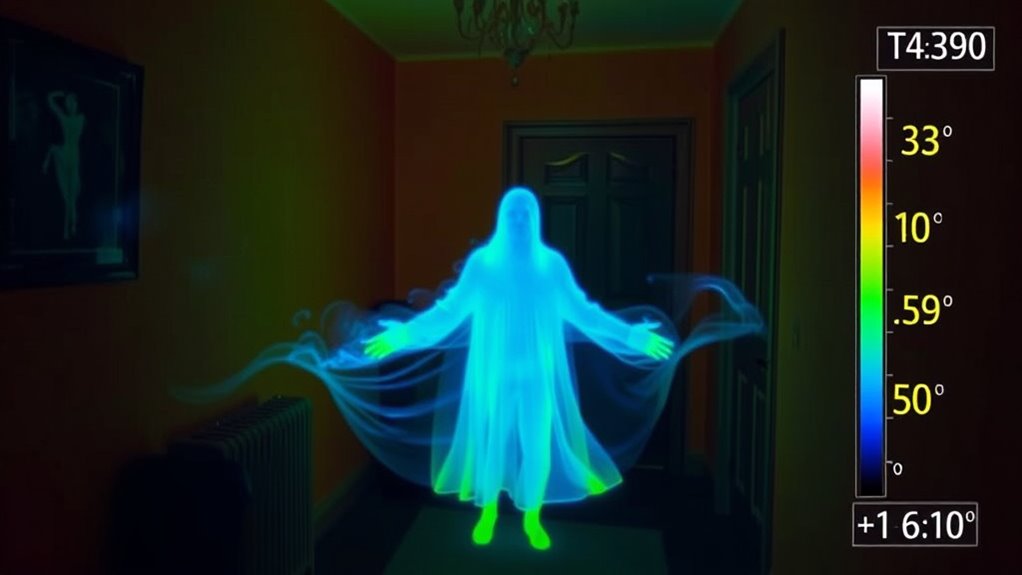
When you’re curious about how thermal cameras work, you’ll find that they detect infrared radiation to create images based on temperature differences.
These thermal imaging cameras utilize a microbolometer sensor that converts infrared radiation into a thermogram. In this visual representation, warmer objects appear brighter, while cooler ones show up darker.
This technology is essential for identifying heat patterns, making it invaluable for applications like firefighting, building inspections, and even paranormal investigations.
Popular brands like FLIR, Hikmicro, and Fluke offer various models with different features and sensitivities, catering to specific needs.
How Does a Thermal Camera Work?
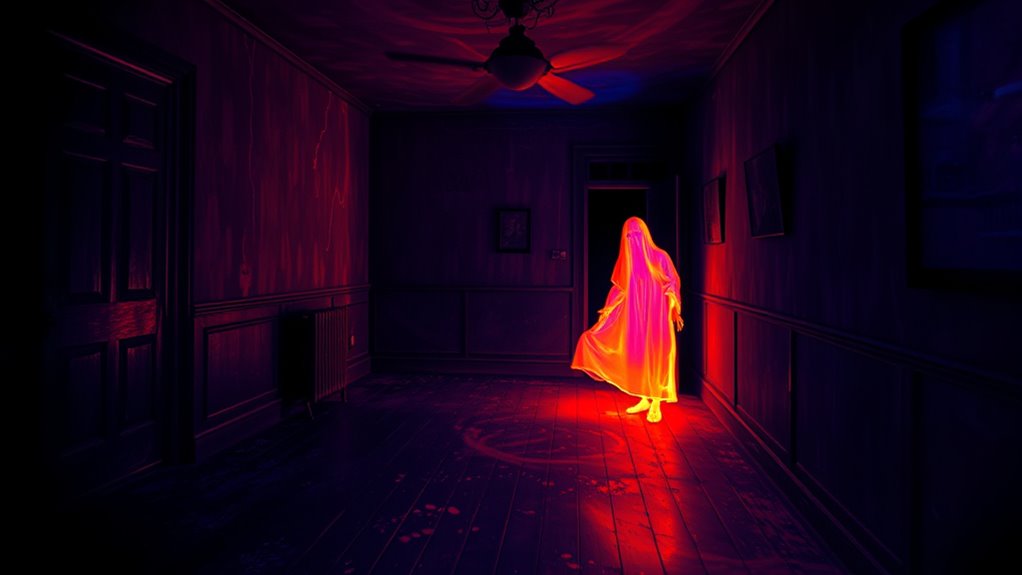
Thermal cameras operate by detecting infrared radiation emitted from objects and converting that data into a visual format called a thermogram. The core component, a microbolometer sensor, measures temperature changes through this radiation.
Thermal cameras detect infrared radiation and visualize it as thermograms, utilizing a microbolometer sensor to measure temperature changes.
- Warmer objects appear brighter, while cooler ones look darker.
- This allows you to easily identify temperature differences in your surroundings.
- The technology relies on thermography, utilizing heat instead of visible light.
- It’s especially effective in low-light conditions, making it perfect for ghost hunting.
The Role of Thermal Cameras in Ghost Hunting

Ghost hunters rely heavily on thermal cameras to uncover potential paranormal activity during their investigations. These essential tools detect temperature variations, which can indicate the presence of spirits.
By visualizing infrared radiation, thermal cameras help you distinguish between genuine apparitions and false positives from reflections or residual heat. This objectivity allows you to assess potential paranormal phenomena more accurately, providing valuable data to analyze alongside other evidence.
Brands like FLIR and Hikmicro offer models tailored for both amateurs and professionals, ensuring you’ve got the right equipment for ghost hunting.
However, understanding environmental factors like drafts and insulation is critical to interpreting your readings correctly. With the right approach, thermal cameras can enhance your ghost hunting experience considerably.
Spotting Cold Spots
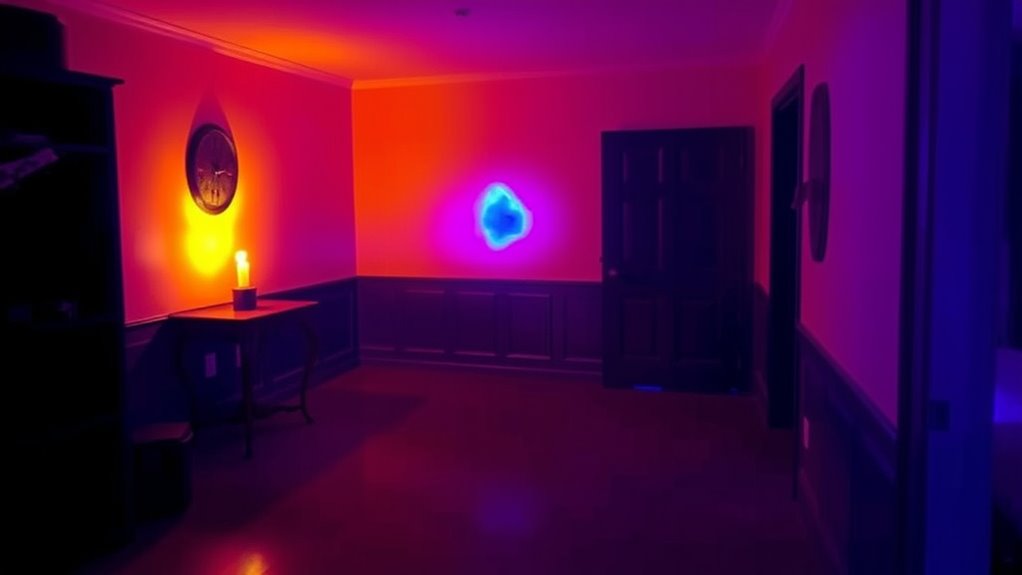
When you’re out ghost hunting, spotting cold spots can be a key indicator of paranormal activity.
Using thermal cameras, you can identify these chilly areas, but it’s important to take into account environmental factors that might cause the temperature drops.
Identifying Cold Spot Areas
Have you ever wondered why certain areas in a location feel inexplicably colder than others?
These unexplained cold spots often pique your interest during ghost hunting. Using a thermal camera for ghost investigations can help you identify these chilling anomalies.
Here are some key aspects to contemplate:
- Look for consistent temperature drops in specific areas.
- Keep track of your movements to avoid residual heat interference.
- Investigate further to rule out drafts, dampness, or air leaks.
- Combine thermal readings with environmental analysis for accurate assessments.
Environmental Causes Explained
While exploring cold spots, it’s essential to recognize that many environmental factors can create these temperature anomalies. Drafts, water damage, and missing insulation often mimic the characteristics of ghostly phenomena.
When you use thermal cameras, these cold spots appear as dark areas on the thermogram, revealing potential temperature changes that may not be paranormal. However, you need to differentiate between natural variations and signs of supernatural activity; dampness in buildings can also create cold patches.
Conducting a thorough environmental analysis is vital to avoid misinterpreting these anomalies. By understanding these environmental causes, you can more accurately assess whether what you’re seeing with your thermal camera is truly indicative of paranormal presence or just a byproduct of the surroundings.
Investigative Techniques for Detection
To effectively spot cold spots during your investigation, you’ll want to utilize thermal cameras, as they can highlight temperature variations that may suggest paranormal activity.
Here are some key techniques to keep in mind:
- Use a thermal imager to identify areas with significant temperature drops.
- Conduct temperature readings over time to spot consistent cold anomalies.
- Be mindful of residual heat from previous occupants that could mislead your findings.
- Document locations, conditions, and thermal images to build a thorough case.
Detecting Heat Signatures

When you use thermal cameras, you’ll start to notice distinct heat patterns that can reveal more than just temperature differences.
Identifying cold spots is key, as these unusual temperature drops might signal paranormal activity.
Additionally, understanding residual heat signatures can help you differentiate between environmental factors and potential ghostly presences.
Understanding Heat Patterns
Detecting heat signatures is at the heart of using thermal cameras for spotting anomalies, including potential ghostly activity. By measuring infrared radiation, these cameras allow you to visualize temperature variations and recognize unusual patterns.
- Warmer objects shine brighter, making it easier to spot anomalies.
- Heat patterns can reveal residual heat from people or objects.
- Understanding these patterns helps distinguish genuine paranormal signs from environmental factors.
- Successfully interpreting thermal images requires practice and attention to detail.
When you explore your surroundings with a thermal camera, focus on the heat emitted by various objects. This understanding of thermal energy can enhance your ghost-hunting experience and help you identify possible paranormal activity more effectively.
Identifying Cold Spots
As you explore an area with a thermal camera, keep an eye out for cold spots—regions where the temperature markedly dips compared to the surroundings. These dark spots on your thermal image can indicate potential paranormal activity. However, it’s crucial to differentiate between true cold spots and common environmental factors like drafts or water damage.
| Cold Spot Characteristics | Potential Causes |
|---|---|
| Significant temperature drop | Ghostly presence |
| Minor temperature variation | Drafts or insulation issues |
| Consistent cold area | Water damage |
Carefully analyze these temperature variations to verify you’re documenting genuine anomalies. By identifying and capturing evidence of cold spots, you can enhance your investigation and better assess the possibility of paranormal encounters.
Residual Heat Signatures
Residual heat signatures can provide intriguing insights during your ghost-hunting investigations.
By utilizing thermal cameras, you can detect these lingering thermal patterns left by people or objects.
However, it’s essential to contemplate a few factors:
- Track your team’s movements to avoid misinterpreting heat as paranormal.
- Heat can be retained in surfaces like furniture and walls, leading to misleading images.
- Accidental identification of heat from pets or former occupants can skew results.
- Understanding the dissipation time of heat helps distinguish human activity from potential ghostly presence.
Distinguishing Reflections From Apparitions
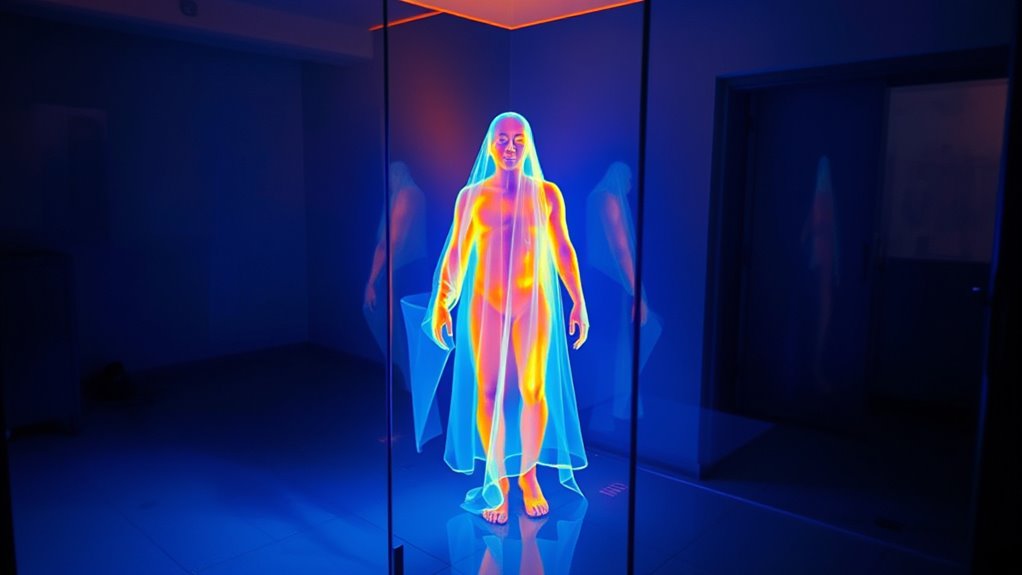
While exploring haunted locations, you might find that reflective surfaces can easily deceive your thermal camera, making it tough to differentiate between genuine apparitions and mere reflections. Understanding these differences is essential for accurate ghost hunting.
| Surface Type | Reflection Risk | Tips for Identification |
|---|---|---|
| Mirrors | High | Check camera angle |
| Glass windows | Moderate | Look for outdoor movement |
| Polished floors | High | Observe lighting changes |
| Granite surfaces | Moderate | Use multiple angles |
| Windows with drapes | Low | make sure drapes are closed |
Common Misinterpretations and Pitfalls
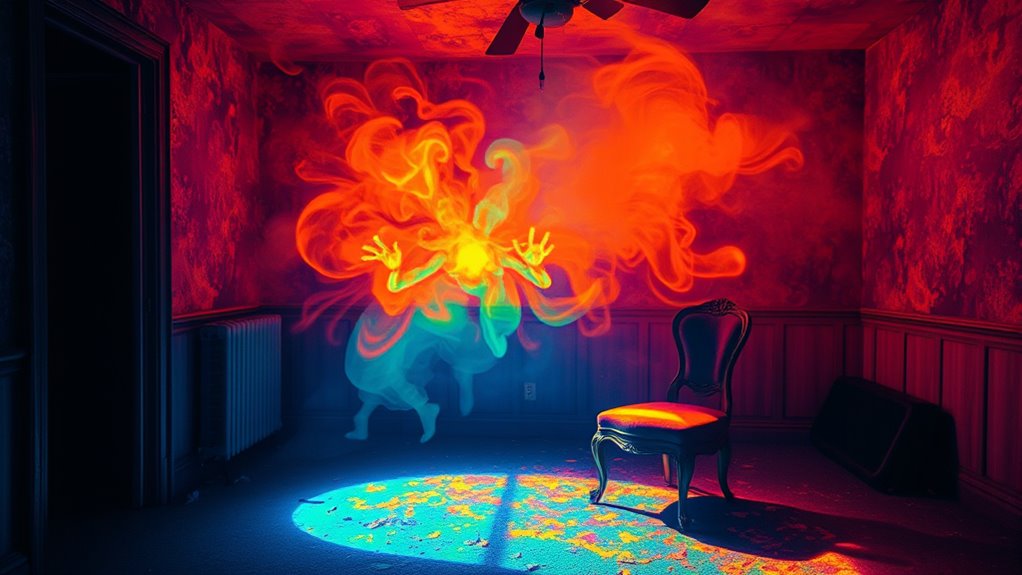
When using thermal cameras, it’s easy to mistake reflections from mirrors or glass for ghostly figures.
You might also misinterpret cold spots caused by drafts or insulation issues as signs of paranormal activity.
Understanding these common pitfalls can help you make more accurate assessments during your investigations.
Reflective Surfaces Confusion
Reflective surfaces can easily lead to confusion during ghost hunting, often resulting in misinterpretations of thermal images.
To avoid accidental identification of anomalies, keep these points in mind:
- Mirrors and glass can distort thermal imagery, creating false positives.
- Reflections from outdoor views through windows may confuse your readings.
- Highly polished materials, like wood or granite, can mimic thermal signatures.
- Always analyze your surroundings to account for potential reflections.
Misinterpreting Cold Spots
Misinterpreting cold spots can be one of the biggest pitfalls in ghost hunting, especially after grappling with the confounding effects of reflective surfaces.
While thermal cameras can identify these cold areas, you must consider environmental factors before jumping to conclusions about paranormal activity. Cold spots can result from drafts, water damage, or missing insulation in buildings.
Many hunters mistakenly attribute these temperature drops to spirits without investigating the underlying causes, like electrical faults or plumbing issues. To accurately identify cold spots, observe your surroundings carefully.
Nearby heat sources or residual warmth can lead to false interpretations about ghostly presence. Always rule out natural explanations to avoid misinterpretation and enhance your ghost hunting experience.
Choosing the Right Thermal Camera for Ghost Hunting

Choosing the right thermal camera for ghost hunting can greatly enhance your chances of detecting paranormal activity. When selecting a model, keep these key features in mind:
- Reputable Brands: Opt for thermal cameras from trusted names like FLIR, Hikmicro, or Fluke.
- High Resolution & Sensitivity: Look for cameras that accurately detect temperature variations, essential for spotting ghosts.
- Portability & Ease of Use: Choose lightweight models that are easy to handle during investigations.
- Thermal Sensitivity: Higher sensitivity allows you to identify subtle temperature differences, helping you find cold spots or residual heat.
How to Effectively Hunt Ghosts With Thermal Cameras
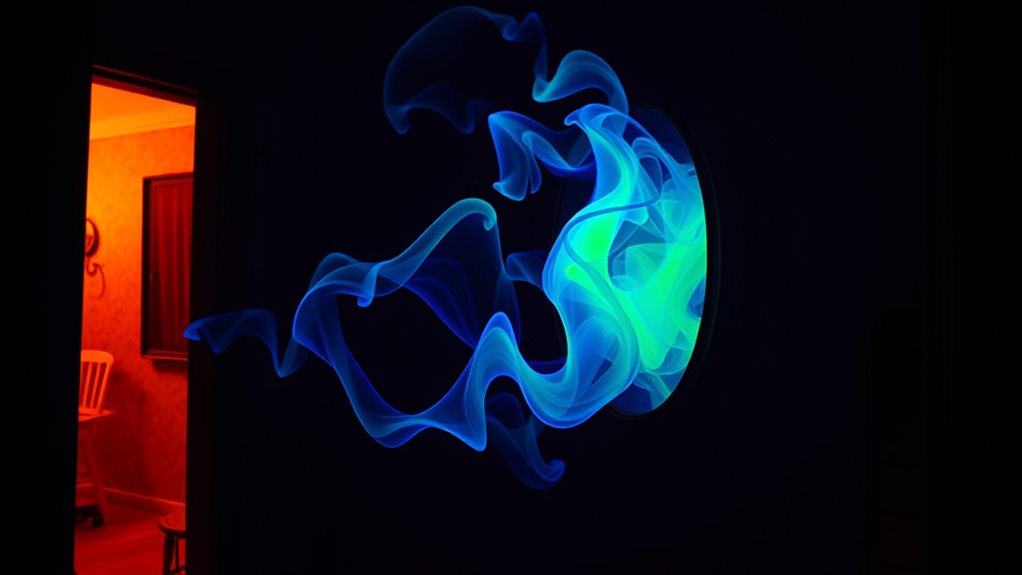
When you’re ready to hunt ghosts with thermal cameras, understanding how these devices work is crucial for effective investigations. Thermal cameras detect infrared radiation, helping you visualize temperature variations that could indicate paranormal activity.
Choose a high-quality thermal camera, like the FLIR ONE Pro or Hikmicro, for maximum resolution and sensitivity.
As you conduct ghost hunting, stay aware of common misinterpretations; reflections in mirrors or glass can easily confuse you. Document your findings meticulously by capturing images and temperature readings for later analysis.
Finally, approach your results critically—consider drafts or residual heat from previous occupants before jumping to conclusions about anomalies. This balanced approach guarantees responsible ghost hunting and enhances your overall experience.
Professional Thermal Imaging Cameras

Professional thermal imaging cameras are essential tools for serious ghost hunters who want to capture accurate and detailed thermal data.
Professional thermal imaging cameras are crucial for dedicated ghost hunters seeking precise thermal data for their investigations.
These devices, like the FLIR ONE Pro, allow you to identify temperature variations that may point to paranormal activity.
Here are some key features to take into account:
- High-resolution images for spotting subtle thermal anomalies
- Compact and user-friendly designs, perfect for all experience levels
- Advanced sensitivity and accuracy for reliable results
- Integration of thermal and visual imaging for thorough analysis
With options ranging from basic models around $200 to advanced units exceeding $500, investing in professional thermal imaging cameras can greatly enhance your ghost hunting experience.
Choose wisely, and you’ll be better equipped to uncover the mysteries that lie in the dark!
Frequently Asked Questions
Can Thermal Cameras Detect Dead Bodies?
Yes, thermal cameras can detect dead bodies. They pick up residual heat emitted from a body for a period after death, which helps locate it in various environments.
However, their effectiveness can depend on factors like surrounding temperature and insulation. If a body is buried or hidden, thermal cameras might struggle due to soil temperatures or obstructions.
Can a Thermal Camera Detect Hidden Cameras?
Yes, a thermal camera can detect hidden cameras, but its effectiveness depends on several factors.
If the hidden camera’s circuitry is active, it’ll emit heat that your thermal camera can pick up. However, if the camera is turned off or designed to minimize heat, you mightn’t spot it.
Regularly scanning areas of concern can help you identify unusual heat patterns that suggest the presence of hidden surveillance devices.
How to Trick Thermal Imaging?
Like a magician’s sleight of hand, tricking thermal imaging requires clever tactics.
You can use reflective surfaces, like mirrors or glass, to confuse the camera’s readings. Introducing residual heat sources, such as warm objects, can lead to misinterpretation of thermal signatures.
Additionally, creating cold spots with ice packs or manipulating airflow can mimic unusual temperature changes. Understanding your environment’s thermal patterns is key to effectively manipulating perceptions and achieving the desired effect.
Can Thermal Cameras Detect Drugs?
Thermal cameras can’t directly detect drugs. They measure heat signatures and can show temperature variations, which might hint at concealed substances.
However, these cameras can’t distinguish between drugs and other materials based solely on thermal readings.
While some law enforcement agencies use them to spot unusual heat patterns linked to drug activities, like grow operations, it’s essential to couple thermal imaging with other investigative methods for a clear understanding.
Conclusion
In the dim light of an old, creaking house, you raise your thermal camera, heart racing with anticipation. Suddenly, a mysterious cold spot flickers into view, sending a shiver down your spine. It’s just you and the shadows, the air thick with possibilities. Each heat signature captured could be a whisper from the past, a fleeting moment of connection. So, gear up, because with the right tools, you might just uncover the secrets hidden in the darkness.




